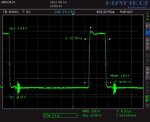gta18
Newbie level 5
I am currently trying to design a mosfet driver for a home made ac tig welder.
Having the max frequency of say 500hz on the output of the bridge inverter and a constant 20v supply for the gate driver circuit, what do you think will happen if I put say 4 sets of 5 mosfets in parallel to build the bridge. (each mosfet is rated 150v 118A ea with rds on of 4.5mohm)
I am planning to use to half bridge driver chips 3 amps rating fan7392. I was thinking what would be the effect of not putting gate resistors on the mosfets? would it switch faster or I burn up something>?
:-D
Having the max frequency of say 500hz on the output of the bridge inverter and a constant 20v supply for the gate driver circuit, what do you think will happen if I put say 4 sets of 5 mosfets in parallel to build the bridge. (each mosfet is rated 150v 118A ea with rds on of 4.5mohm)
I am planning to use to half bridge driver chips 3 amps rating fan7392. I was thinking what would be the effect of not putting gate resistors on the mosfets? would it switch faster or I burn up something>?
:-D
